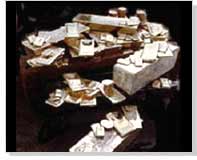 The use of silver dates back to the earliest historic times, and it was generally extracted by melting silver - bearing lead ore (ore consisting argentiferous galena). The least expensive of precious metals, silver is a white element, which has the highest thermal and electrical conductivity of all the metals. Earlier, the primary use of silver was in coinage, decorative articles, jewelry, and silverware. In modern times, coinage has become an insignificant use and the aesthetic applications has been surpassed by technical and industrial uses. Technical and industrial uses of silver include - brazing alloys, catalysts, electrical / electronics products, and photographic paper and film. Recycling of silver present in these materials is a major source of silver supply.
The use of silver dates back to the earliest historic times, and it was generally extracted by melting silver - bearing lead ore (ore consisting argentiferous galena). The least expensive of precious metals, silver is a white element, which has the highest thermal and electrical conductivity of all the metals. Earlier, the primary use of silver was in coinage, decorative articles, jewelry, and silverware. In modern times, coinage has become an insignificant use and the aesthetic applications has been surpassed by technical and industrial uses. Technical and industrial uses of silver include - brazing alloys, catalysts, electrical / electronics products, and photographic paper and film. Recycling of silver present in these materials is a major source of silver supply.
|
Photo Finishing Industrial X-Ray Metal Plating Paper Flake Ash Solutions Sludge MetallicReplacement Cartridges Electrolytic Equipment Lead Foil |
In the year 2000, the global silver supply deficit (the difference between mine and scrap supply and demand of silver) was more than 3,000 metric tons. Increasing day by day, this deficit is making the producers to look for alternatives, such as silver recovery and recycling. The major sources of materials for silver recycling are photographic wastes, electronic scrap and spent catalysts are the major sources of materials for silver. About 1,800 metric tons of silver contained in these materials were available for recycling in 2000. Some other recyclable silver-bearing materials, include - dental alloys, jewelry, and silverware.
Who generates silver waste?The prime sources of silver waste include graphic arts, industrial x-ray, photo finishing, and metal plating industries. Silver waste comes in various forms and types, including - photographic film, flake, paper, ash, solutions, sludge, metallic replacement cartridges, electrolytic equipment, and lead foil.
Silver scrap is generated mainly in the industrialized nations that indicates the demand for silver is skewed towards industrialized countries. Also, silver-bearing scrap is primarily from photographic and electronics sources. Silverware and jewelry are of less important as a source of recycled metal. This is crucial because in spite of high growth in demand in developing countries, consumption of silver in photography and electronics in 2000 was still biased towards the United States, Europe, and Japan. By contrast, demand for silver in jewelry was dominated by India and other Asian countries where the recycling rates are conventionally very high.
Processing of Silver Scrap -Silver scrap is processed using various methods and techniques, which depends on the nature and type of silver scrap. The different types of silver scraps can be - Silver scrap is processed using various methods and techniques, which depends on the nature and type of silver scrap. The different types of silver scraps can be -
- Photographic Wastes
- Electrical & Electronics Scrap
- Jewelry & Silversmith Scrap
Photographic Wastes
A variety of techniques are available for removing silver from silver-rich photographic processing solutions. Of these, 3 are used in almost all practical processes of silver recovery - electrolysis, metallic replacement, and precipitation.
|
waste dreams Purchase recovered silver from the generator Pick up silver waste from the generator's facility Prepare silver for refining Sell silver to a refinery recycling facility Prepare silver for refining Sell silver to refinery |
Silver recoverers provide on-site silver recovery consulting services with silver recycling. A recoverer will generally assist the silver waste generator in recovering silver from waste streams, purchase recovered silver from the generator, pick up the silver waste from the waste generation facility, process and sell the silver to a refinery. Silver recyclers generally do not provide on-site consulting or pick up of silver waste. A recycler will usually purchase silver waste delivered to the recycling plant, process it and sell the silver to a refinery.
